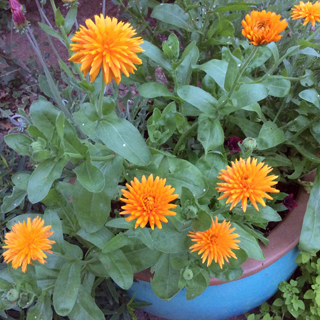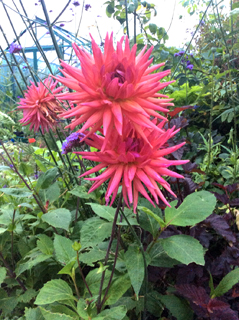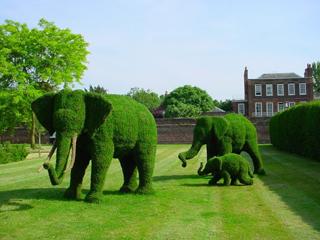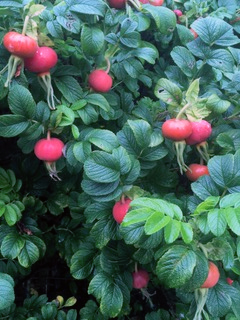
As we embark on this month’s column, the natural place to start is a look back at last year’s, to make sure we’re giving you something fresh to think about. It was an interesting exercise, not for the words so much, which are still highly relevant, as the pictures we used, all taken in Helen’s garden. Last year we showed you a big pot calendula, a lovely dusty pink dahlia in full bloom, salvia Black and Bloom and helenium Moerheim Beauty, also in full flower.
Of those, this year only the helenium is at the same stage of flowering, and the rest are way behind. None of those were new plants last year, so that’s not the reason, but it highlights how much the weather conditions play a part in how and when our plants perform. Usually, August is the time we are scrabbling round for interest in the garden, but this year it seems we may have more simply because things are later. There you are. The British and particularly the Cornish climate always surprises so be adaptable and understanding of your garden – it is mostly out of your control.
 So, what to do this month? Well, not much if you don’t want to. Now is the time to enjoy your garden, and bar a little tidying, deadheading and gap-filling, you should cut yourself some slack. There are no major jobs on the cards.
So, what to do this month? Well, not much if you don’t want to. Now is the time to enjoy your garden, and bar a little tidying, deadheading and gap-filling, you should cut yourself some slack. There are no major jobs on the cards.
What you can do, if it remains relatively cool and damp, is trim up those evergreen shrubs you probably should have done a month ago, but ran out of time. We all have some. Rather than major surgery, which may overstress the plant, stick to light trimming, and you should get away with it. For example, topiaried box, ligustrum, lonicera and holly probably needs a little haircut to keep its defined shape clear and crisp, so grab the tool of your choice (we use herbaceous shears which are great, but sharp, so be careful) and trim away. It is remarkably therapeutic, but reminds both of us why we work with plants and are not hairdressers. Luckily, like hair, it’ll grow back…
 When you are deadheading the roses, a very British past time, be mindful of the type of rose you are dealing with. There are some shrub roses, particularly the species roses, which are as valued for the hips they set as the flowers. Examples of such roses are rosa moyesii (and its slightly more controllable off shoot r. moyesii Geranium), r. rugosa (all varieties), r. glauca rubrifolia and the native species, r.arvensis (the field rose) and r.canina (the good old dog rose). Do NOT deadhead these types, as they are single flowerers, and you will lose the beautiful and bright hips that follow.
When you are deadheading the roses, a very British past time, be mindful of the type of rose you are dealing with. There are some shrub roses, particularly the species roses, which are as valued for the hips they set as the flowers. Examples of such roses are rosa moyesii (and its slightly more controllable off shoot r. moyesii Geranium), r. rugosa (all varieties), r. glauca rubrifolia and the native species, r.arvensis (the field rose) and r.canina (the good old dog rose). Do NOT deadhead these types, as they are single flowerers, and you will lose the beautiful and bright hips that follow.
They are a thing of beauty for us, and a great food source for the birds over autumn and winter. The rosa rugosa group is full of fantastic plants for our windy, coastal conditions and as long as you don’t mind donning gauntlets to deal with them, make an invaluable addition to our gardens. Tough as old boots, will take just about anything you throw at them, and beautiful besides. You will see them right on the dunes at Pendower Beach so that tells you what they will take. Depending on the variety, they are already putting out big fat hips even now. In fact, the chap who came to service Helen’s boiler this week looked at them and asked “is that a tomato plant?” We think he should stick to boilers… ahem. Bless.

We know we have banged on about these before, but we like to think we are cutting edge with our plant choices. Dahlias, once the bastion of the vegetable gardeners and hoary old sorts entering the village shows, are fashionable again. Oh yes, believe it, people. They are glorious and come in every conceivable colour and shape.
We were slightly offended this week when one regular customer bought one “as a joke” for a friend, but really, just look at the range available and we guarantee there is at least one that you can’t help saying, ooooh, I quite like that. In our view, the last thing the gardening world should be is snooty and exclusive so if you like it, go for it. They are so easy to grow, and down here in a well drained spot, you don’t even need to lift them in the winter. Just protect the new growth against slugs and you will have a growing clump of beauty year on year. And they can be shared with friends – the tubers multiply and you can cut some off in the spring to give away.

If, like us, you feel the need to twiddle in your greenhouse even when you have the opportunity to do nothing, then now is the time to start off some hardy annual seeds, or even some perennial seeds for next year. Last year, we set off cornflowers, larkspur, catananche and antirrhinum towards the end of August for blooming this year, and they turned out absolutely gloriously.
They make fantastic cut flowers too. They were robust enough to plant out in October and then left to their own devices over the winter. Because they are hardy, the winter did not deter them and they turned out to be lovely, strong tall plants. There are lots of other seeds which benefit from sowing now, so have a rummage around and find something that suits you. This year, we have sweet Williams on the go, together with some shrubby echiums, and the sweet peas will go in probably in September/October.

One final small job – tomatoes and cucumbers are now in full production. As such, they are very hungry, so make sure you give them a good feed once a week with something high in potassium. You can tell if your feed is high potassium by checking the chemical content on the labelling on the back. If the percentage number next to the K symbol is into double figures, it is a high potassium feed. This will feed all fruit, veg and flowers effectively. If it calls itself “tomato feed” it will be higher in potassium and will do the trick, but if you want a more organic solution (say, seaweed or comfrey) check the labelling carefully. If your feed is higher in nitrogen (the N symbol), it will be feeding the leaves more than the fruit, so leave that aside for the moment.
Next month, autumn will be approaching so there will more jobs to do, but in the meantime, enjoy the respite, and more importantly, the fruits of your labour.
Sarah Daniel and Helen Robins, Pengelly Garden Centre

